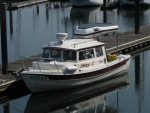thataway":c94uysxa said:
Sunbeam, explain why you think
"for certain situations you don't gain as much with MPPT as you do with others,"
Well first of all, I need to say that I am so far from an expert that it is not even funny. I usually try not to get "technically detailed" on things that I don't totally grasp, so I probably should have simply kept my mouth shut, but... I didn't :wink: So here goes: I'm in the learning stages, and what I did was read up on it online (where of course there is almost too much information, and people don't always agree, but it's still useful), and then talk to some people who understand more than me (one person who has had solar on many RV's, and then the company AM Solar, which I stopped at on my way north last month - great place to see/try out many controllers and talk to people directly). So, please don't take this as gospel, because it's possible I don't have it quite right, mis-remembered, etc. I took away the gist but wasn't really trying to "know" everything.
So, it seems that an MPPT controller is generally always a good thing, but sometimes someone might still choose a PWM for certain reasons. Here is what I remember:
1) MPPT likes all your panels to be at around the same voltage. On my RV roof, the available areas are odd shapes, and so the best arrangement wattage-wise would mean one panel with a voltage that varies by over 1 volt. This apparently doesn't work so well with an MPPT controller -- you are recommended to have panel voltages within 1/2 or maybe 1 volt of each other. I contacted two controller mfgrs, asking about the example of a 160 watt panel (in addition to a few other 100 watters which are all at the same voltage; the 160 is about 1.5 volts higher)and an MPPT controller, vs. a 135 watt panel (wherein all panels would be the same voltage). In other words, giving up 25 watts for a solid match as recommended; or gaining 25 watts but with a slight mis-match. The standard recommendation for mismatching voltage that I got was "PWM controller."
Neither company could answer that for certain. They knew the 135 would work well due to matching voltages, but really couldn't say where the "break point" was with the inefficiency/problem vs. the more wattage. Or if the controller would be negatively affected.
OTOH, I have a friend who had to replace one of a set of matched panels (lightning damage), and the new panel had to be a different voltage (availability), and he didn't really notice a lot of real world difference (he has an MPPT controller). So it's a question point. Of course this only applies if one wants/needs to have two or more panels which are not all exactly the same voltage.
2) MPPT can handle panels with higher voltages, which can allow for thinner wire runs - but I will most likely be going with "12 volt" panels (really usually around 17-18 volts), so that advantage does not apply.
3) For a very small system (one panel or so), the higher efficiency of the MPPT doesn't end up being as much (because you just have fewer things happening overall, so there is less to be efficient with) and in that case a person might prefer to go with less expensive PWM (although of course the MPPT are getting cheaper most likely so that difference may be moot at some point).
I will probably go with a small MPPT on the boat regardless of the difference in cost. I don't have room or desire for more panels, and so I'd be willing to "overpay" for a slight bit of more efficiency; but this is an individual decision. And too, I will have all same voltage panels there so no questionable problem that way with MPPT. (My question was about the RV, which has an "odd shaped" roof and so requires a mixing and matching of panels to get the wattage up there.)
4) There may be some cases where it is cheaper/better to just "throw more panels at it" (e.g. you have plenty of space, MPPT is expensive if you have a huge array, panel prices have come down etc.), but those would not apply to our boats or to smaller RV's in any case. Probably more applicable to land-based systems.
Here is one example of a discussion, albeit it's from 2011 so not totally current:
http://forum.solar-electric.com/showthr ... ll-systems
Again, I'm going to get an MPPT controller, so I'm not arguing against them; it just seemed that there were some cases in which PWM might be a decent alternative choice (and Carpy had just mentioned that he had one).
Sunbeam

